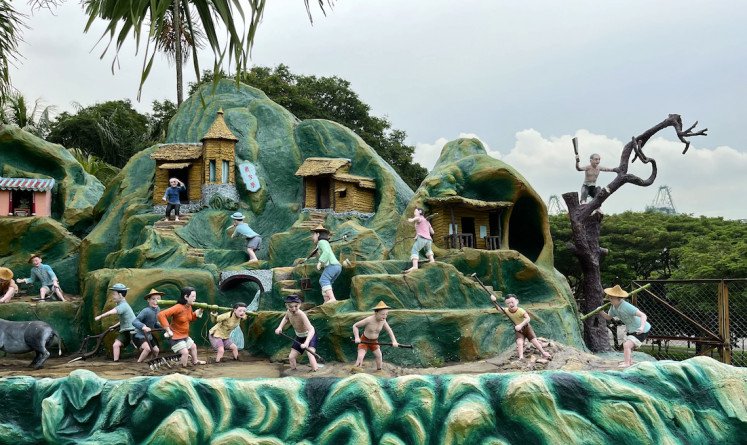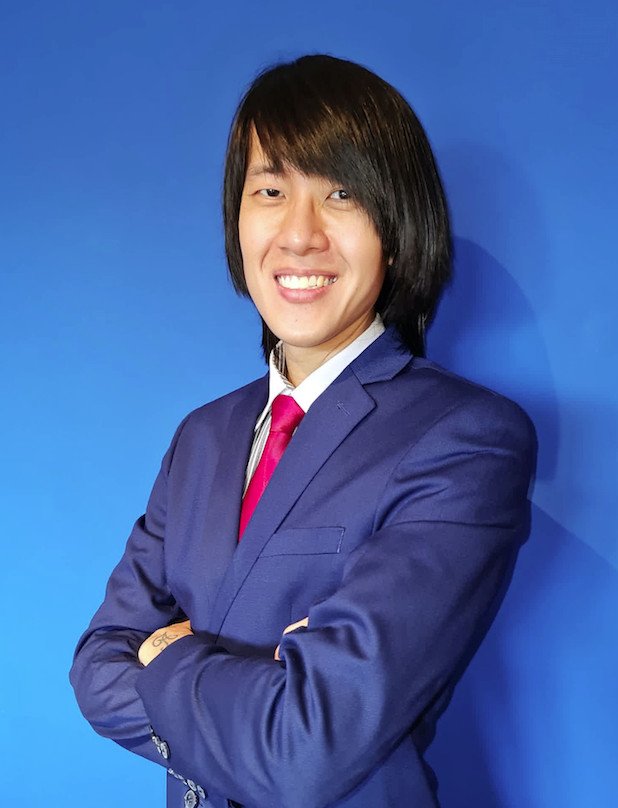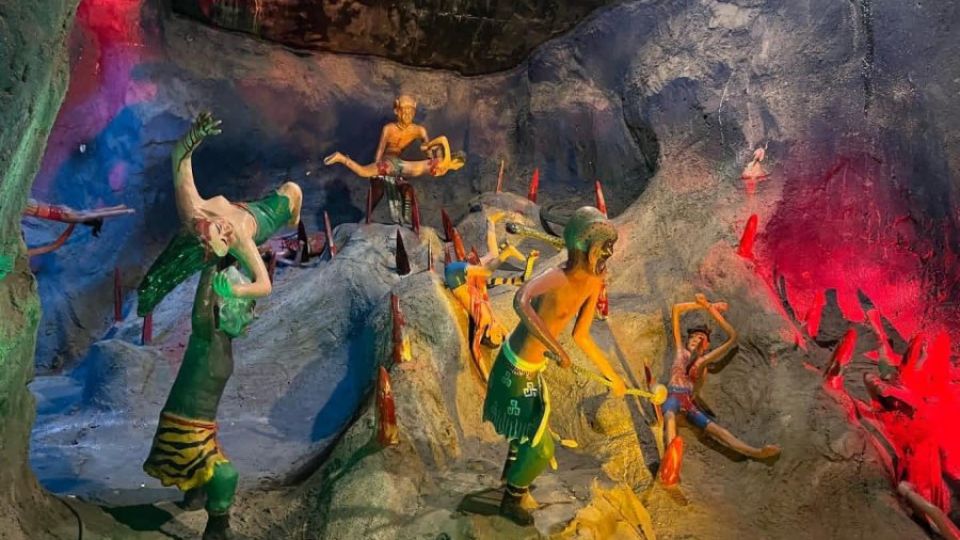February 10, 2023
JAKARTA – Aw Boon Haw, one of the original ‘crazy rich Asians’, created Haw Par Villa to teach people the value of good karma.
Founded in 1937, Haw Par Villa is the original Singapore amusement park. Colorful statues of animals and scenes from Chinese folklore, such as Madam White Snake, adorn its one-of-a-kind front.
However, a tragic history hides beneath its vibrant and varied exterior.
The park’s popularity has also reached several neighboring countries, including Indonesia. One of Indonesia’s horror YouTubers, Billy Christian, shot a video four years ago during a promotion of a movie called Mereka Yang Tak Terlihat (They Who Are Not Seen). The video reached 85,311 views, and viewers reacted positively to the vlog, using it to reminisce about their lives.
“A vivid depiction of everyday scenes comes alive at Haw Par Villa. Every seed sown in this life is reaped in the next one,” wrote one of an account named Agustin Sofian Putri.
Jennifer Makaria, who spent her teenage years in Singapore, shared her little memory about the theme park.
“I couldn’t remember it a lot,” said the 24-year-old. The oldest of two siblings remembered the gory scenery of the park and reflected on her deeds.
“Maybe more like each bad behavior comes with its consequences, but not until in hell can I experience the consequences,” she said.
History
Aw Boon Haw’s feelings for his brother Aw Boon Par were the impetus for everything that followed. As entrepreneurs and philanthropists, the Aw brothers were the so-called “Crazy Rich Asians” of their time, and their most notable legacy was the development of Tiger Balm.
The two were born in Rangoon, now Yangon, in Burma. In 1926, they uprooted their lives and shifted the Tiger Balm business empire to Singapore, where they ran a successful ointment enterprise.

Good deeds: Haw Par Villa hopes to teach younger generations about the importance of caring for each other (JP/Yohana Belinda) (JP/Yohana Belinda)
There were not many accessible public venues for Asians during colonial times in the 1930s. Haw Par Villa, formally known as Tiger Balm Gardens, was constructed to meet the needs of the public in Singapore.
The vast white home was situated on 3,800 square meters of land before becoming famous as a theme park filled with thousands of colorful and eccentric sculptures. Boon Par fled the home in Singapore. Boon Haw was in Hong Kong when war broke out in the Pacific in 1941. He was not in Singapore.
During the Japanese Occupation, Boon Haw was allowed to run the Tiger Balm business in Hong Kong. At the start of the conflict, Boon Par fled Singapore for Rangoon. He did not stay in Singapore. The Japanese seized the Singapore part of the Tiger Balm business. Boon Par died in 1944 at the age of 59. The brothers were unable to reunite with each other.
The house served as a base of operations for Japanese troops overseeing shipping activity to and from Pasir Panjang during the war.
Boon Haw was able to return to Singapore after the Japanese surrendered in 1945, but he never got to see his brother again. They were unable to spend their final moments together. After seeing the wreckage of his villa, Boon Haw decided to demolish it.
On Nov. 26, 2022, April, a tour guide gave an overview of Hell Museum’s history, explaining how Boon Haw wanted to teach young people essential lessons by constructing the Ten Courts of Hell, which Boon Haw managed single-handedly.
“I’m going to guide you to hell,” April said to the tourists exploring Singapore’s oldest theme park. Boon Haw died in 1954, and his nephew, Cheng Chye, eventually took charge of the theme park.
In 1985, the Singapore government did not buy the property. They acquired the land on which the park stood through the Land Acquisition Act.
Tickets to see the Hell Museum cost SG$18 (US$13.61) per person and the museum is open every Wednesday to Sunday, 10 a.m – 6 p.m (last entry 5 p.m). It is also available on public holidays. Visitors can tour “hell” and think about their accumulated good and bad karma.
Even though Hell Museum is a ticketed entry, the remainder of the park is open to the public without charge.
10 Courts of Hell
In ancient Chinese belief, those who have died will meet King Qinguang in the first court seven days following death. The king will weigh the individual’s good and bad deeds. If they have led a virtuous life, they could be reborn as a deity or human being. Otherwise, they must go through the rest of the courts and endure judgment and punishment for sins committed.
Haw Par Villa was famously known as a place where parents taught their children about good karma. Before the COVID-19 pandemic hit in early 2020, secondary school students comprised 8 to 15 percent of the total visitorship to Haw Par Villa.
Parents tell children that those judged as sinners will be punished in the appropriate courts, such as the second court. There, robbers will be thrown into a volcanic pit, and those who are corrupt will be frozen into blocks of ice. Those who have engaged in prostitution will be thrown into a pool of blood and left to drown.
The sins of disrespecting elders, being ungrateful and attempting to escape from prison might result in the dismemberment of one’s heart as a punishment in the third court of King Songdi.
That is not all! Drug users and traffickers will be roasted while chained to a red-hot copper pillar as further punishment for their sins.
Tax evaders and business fraudsters are transferred to King Wuguan’s fourth court to face the stone mallet. In addition, being ground by a heavy stone is the punishment for the sin of disobedience to one’s siblings and lack of filial piety.
You have already made it halfway around the court, so keep it up! King Yanluo rules over the fifth court of hell. Those found guilty of plotting murder or plotting to steal someone else’s property in the fifth court will be tossed onto a mound of blades.
In the sixth court, there is a tree of knives where offenders of adultery, theft, cursing and abduction will be hanged as punishment. A person’s body will be sawed in half if they are caught with pornographic materials or if they throw away food. Each scene shows how terrible it would be for the guilty and how it would feel like an eternity in hell.
Those who spread falsehoods and cause strife in their communities and families will be punished by having their tongues torn out in the Seventh Court of Hell, which King Taishan guards. Concurrently, anyone responsible for someone else’s death, such as rapists, will be tossed into a wok of hot oil.
Those who have caused trouble for their parents or other family members or cheated on exams will have their intestines and organs torn out in the eighth court of hell, which King Dushi guards. That was not the end of the bad guys on the eighth court’s punishment system. One’s body will be dismembered if one harms another for one’s advantage.
“It’s the most unforgivable sin to disobey your parents,” April said, reminding all the tourists to be respectful toward their parents.
Those who have committed robbery, murder, rape or other illicit actions are about to have their heads and arms hacked off as they enter the ninth court of hell, which King Pingdeng guards. Those who have ignored the needs of the children and elderly will also be squished under heavy stones.
Finally, in the tenth court of hell, under the watchful eye of King Zhuanlun, each person will be given their final verdict as to where they will be reincarnated. The souls are subsequently taken to Granny Meng, an elderly woman who will offer them a cup of tea, which, when consumed, causes them to forget memories of their previous life and experiences in Hell.
The dioramas may feature disturbing scenes, but Boon Haw intended them as a teaching tool to educate young people about being good citizens and making positive contributions to the world.
A youngster who gives his stepmother a fish in the snow illustrates how humans should act toward one another.
The farming diorama at the back of Hell’s Museum features a village community where everyone contributes and helps each other. It explains how everyone should be a contributing citizen within their community.
Eisen Teo, a senior researcher at the Singapore History Consultants Pte Ltd and chief curator of Hell’s Museum at Haw Par Villa, said many parents used images of gory punishments and hell guards to discipline their children.
“The 10 Courts of Hell is more than a thousand years old. It is an artistic representation of an abstract set of ideas, combining Hindu, Taoist, Buddhist and Confucian concepts. It is the result of a great exchange of ideas across two ancient civilizations, the Chinese and the Indian,” Teo said.

Philosophical life: For Eisen Teo, Haw Par Villa is about passing down knowledge to younger generations (JP/Yohana Belinda) (JP/Yohana Belinda)
Admiring other cultures
Guests can marvel at dioramas depicting hell’s 10 courts and those representing the many cultures that inspired the park. Teo revealed Cheng Chye, Boon Haw’s and Boon Par’s nephew took care of the business in the 1960s and came up with the idea of International Corners. The idea was to bring the world to Singaporeans, and market Tiger Balm simultaneously.
Hence, Chye ordered special constructions dedicated to countries such as the United States, Italy, Japan, Thailand, Indonesia, Australia and New Zealand.
“To maximize publicity, he would launch each corner with great fanfare, inviting the media and VIPs such as ministers,” Teo said.
A representation of Indonesia could be seen through a Garuda sculpture. Garuda is the half-human, half-eagle mount of Vishnu in Hindu mythology and is worshiped as a divine messenger in many other Asian countries, including India. He carries the gods’ messages and directives to the human race.
After all, according to Teo, Haw Par Villa remains significant to the neighboring country because of their visual representations of famous classics, folk tales and moral teachings many Singaporeans grew up with. Moreover, the park remains significant to others due to its philosophies. There are depictions of Buddha and the Eight Immortals from Taoism. The most well-known example of cultural exchange between different civilizations (particularly ancient China and India) is the concept of the 10 Courts of Hell. This helps to give Singaporeans a sense of cultural ballast, tying them to their roots and identifying them as uniquely Singaporean.
“In a simple visit, visitors can learn so much about culture, religion, philosophy, literature and Asian art and sculptures through a visual medium,” Teo said.
“They will also learn about value systems, entrepreneurship, commonalities across diverse societies and multiracial, multi-religious elements in Singapore,” he added, sharing Haw Par Villa’s role toward modern societies through emails.
“Hopes all these will keep Haw Par Villa relevant to future generations,” Teo closed.


